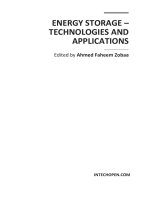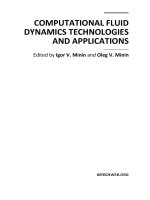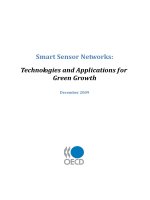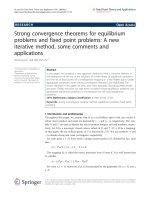ENERGY STORAGE – TECHNOLOGIES AND APPLICATIONS pptx
Bạn đang xem bản rút gọn của tài liệu. Xem và tải ngay bản đầy đủ của tài liệu tại đây (21.22 MB, 328 trang )
ENERGY STORAGE –
TECHNOLOGIES AND
APPLICATIONS
Edited by Ahmed Faheem Zobaa
Energy Storage – Technologies and Applications
Edited by Ahmed Faheem Zobaa
Contributors
Hussein Ibrahim, Adrian Ilinca, Mohammad Taufiqul Arif, Amanullah M. T. Oo, A. B. M.
Shawkat Ali, Petr Krivik, Petr Baca, Haisheng Chen, Xinjing Zhang, Jinchao Liu, Chunqing Tan,
Luca Petricca, Per Ohlckers, Xuyuan Chen, Yong Xiao, Xiaoyu Ge, Zhe Zheng, Masatoshi Uno,
Yu Zhang, Jinliang Liu, George Cristian Lazaroiu, Sonia Leva, Ying Zhu, Wenhua H. Zhu, Bruce
J. Tatarchuk, Ruddy Blonbou, Stéphanie Monjoly, Jean-Louis Bernard, Antonio Ernesto Sarasua,
Marcelo Gustavo Molina, Pedro Enrique Mercado
Published by InTech
Janeza Trdine 9, 51000 Rijeka, Croatia
Copyright © 2013 InTech
All chapters are Open Access distributed under the Creative Commons Attribution 3.0 license,
which allows users to download, copy and build upon published articles even for commercial
purposes, as long as the author and publisher are properly credited, which ensures maximum
dissemination and a wider impact of our publications. After this work has been published by
InTech, authors have the right to republish it, in whole or part, in any publication of which they
are the author, and to make other personal use of the work. Any republication, referencing or
personal use of the work must explicitly identify the original source.
Notice
Statements and opinions expressed in the chapters are these of the individual contributors and
not necessarily those of the editors or publisher. No responsibility is accepted for the accuracy
of information contained in the published chapters. The publisher assumes no responsibility for
any damage or injury to persons or property arising out of the use of any materials,
instructions, methods or ideas contained in the book.
Publishing Process Manager Sandra Bakic
Typesetting InTech Prepress, Novi Sad
Cover InTech Design Team
First published January, 2013
Printed in Croatia
A free online edition of this book is available at www.intechopen.com
Additional hard copies can be obtained from
Energy Storage – Technologies and Applications, Edited by Ahmed Faheem Zobaa
p. cm.
ISBN 978-953-51-0951-8
Contents
Chapter 1 Techno-Economic Analysis
of Different Energy Storage Technologies 1
Hussein Ibrahim and Adrian Ilinca
Chapter 2 Estimation of Energy Storage and Its Feasibility Analysis 41
Mohammad Taufiqul Arif, Amanullah M. T. Oo
and A. B. M. Shawkat Ali
Chapter 3 Electrochemical Energy Storage 79
Petr Krivik and Petr Baca
Chapter 4 Compressed Air Energy Storage 101
Haisheng Chen, Xinjing Zhang, Jinchao Liu and Chunqing Tan
Chapter 5 The Future of Energy Storage Systems 113
Luca Petricca, Per Ohlckers and Xuyuan Chen
Chapter 6 Analysis and Control of
Flywheel Energy Storage Systems 131
Yong Xiao, Xiaoyu Ge and Zhe Zheng
Chapter 7 Single- and Double-Switch Cell Voltage Equalizers for
Series-Connected Lithium-Ion Cells and Supercapacitors 149
Masatoshi Uno
Chapter 8 Hybrid Energy Storage and Applications Based
on High Power Pulse Transformer Charging 177
Yu Zhang and Jinliang Liu
Chapter 9 Low Voltage DC System with Storage
and Distributed Generation Interfaced Systems 219
George Cristian Lazaroiu and Sonia Leva
Chapter 10 In-Situ Dynamic Characterization of Energy Storage
and Conversion Systems 239
Ying Zhu, Wenhua H. Zhu and Bruce J. Tatarchuk
VI Contents
Chapter 11 Dynamic Energy Storage Management for Dependable
Renewable Electricity Generation 271
Ruddy Blonbou, Stéphanie Monjoly and Jean-Louis Bernard
Chapter 12 Dynamic Modelling of Advanced Battery Energy Storage
System for Grid-Tied AC Microgrid Applications 295
Antonio Ernesto Sarasua, Marcelo Gustavo Molina
and Pedro Enrique Mercado
Chapter 1
© 2013 Ibrahim and Ilinca, licensee InTech. This is an open access chapter distributed under the terms of
the Creative Commons Attribution License ( which permits
unrestricted use, distribution, and reproduction in any medium, provided the original work is properly cited.
Techno-Economic Analysis
of Different Energy Storage Technologies
Hussein Ibrahim and Adrian Ilinca
Additional information is available at the end of the chapter
1. Introduction
Overall structure of electrical power system is in the process of changing. For incremental
growth, it is moving away from fossil fuels - major source of energy in the world today - to
renewable energy resources that are more environmentally friendly and sustainable [1].
Factors forcing these considerations are (a) the increasing demand for electric power by both
developed and developing countries, (b) many developing countries lacking the resources to
build power plants and distribution networks, (c) some industrialized countries facing
insufficient power generation and (d) greenhouse gas emission and climate change
concerns. Renewable energy sources such as wind turbines, photovoltaic solar systems,
solar-thermo power, biomass power plants, fuel cells, gas micro-turbines, hydropower
turbines, combined heat and power (CHP) micro-turbines and hybrid power systems will be
part of future power generation systems [2-8].
Nevertheless, exploitation of renewable energy sources (RESs), even when there is a good
potential resource, may be problematic due to their variable and intermittent nature. In
addition, wind fluctuations, lightning strikes, sudden change of a load, or the occurrence of
a line fault can cause sudden momentary dips in system voltage [4]. Earlier studies have
indicated that energy storage can compensate for the stochastic nature and sudden
deficiencies of RESs for short periods without suffering loss of load events and without the
need to start more generating plants [4], [9], [10]. Another issue is the integration of RESs
into grids at remote points, where the grid is weak, that may generate unacceptable voltage
variations due to power fluctuations. Upgrading the power transmission line to mitigate this
problem is often uneconomic. Instead, the inclusion of energy storage for power smoothing
and voltage regulation at the remote point of connection would allow utilization of the
power and could offer an economic alternative to upgrading the transmission line.
Energy Storage – Technologies and Applications
2
The current status shows that several drivers are emerging and will spur growth in the
demand for energy storage systems [11]. These include: the growth of stochastic generation
from renewables; an increasingly strained transmission infrastructure as new lines lag
behind demand; the emergence of micro-grids as part of distributed grid architecture; and
the increased need for reliability and security in electricity supply [12]. However, a lot of
issues regarding the optimal active integration (operational, technical and market) of these
emerging energy storage technologies into the electric grid are still not developed and need
to be studied, tested and standardized. The integration of energy storage systems (ESSs) and
further development of energy converting units (ECUs) including renewable energies in the
industrial nations must be based on the existing electric supply system infrastructure. Due
to that, a multi-dimensional integration task regarding the optimal integration of energy
storage systems will result.
The history of the stationary Electrical Energy Storage (EES) dates back to the turn of the 20
th
century, when power stations were often shut down overnight, with lead-acid accumulators
supplying the residual loads on the direct current networks [13–15]. Utility companies
eventually recognised the importance of the flexibility that energy storage provides in
networks and the first central station for energy storage, a Pumped Hydroelectric Storage
(PHS), was put to use in 1929 [13,16,17]. The subsequent development of the electricity
supply industry, with the pursuit of economy of scale, at large central generating stations,
with their complementary and extensive transmission and distribution networks, essentially
consigned interest in storage systems up until relatively recent years. Up to 2005, more than
200 PHS systems were in use all over the world providing a total of more than 100 GW of
generation capacity [16–18]. However, pressures from deregulation and environmental
concerns lead to investment in major PHS facilities falling off, and interest in the practical
application of EES systems is currently enjoying somewhat of a renaissance, for a variety of
reasons including changes in the worldwide utility regulatory environment, an ever-
increasing reliance on electricity in industry, commerce and the home, power
quality/quality-of-supply issues, the growth of renewable as a major new source of
electricity supply, and all combined with ever more stringent environmental requirements
[14,19-20]. These factors, combined with the rapidly accelerating rate of technological
development in many of the emerging EESs, with anticipated unit cost reductions, now
make their practical applications look very attractive on future timescales of only a few
years.
This document aims to review the state-of-the-art development of EES technologies
including PHS [18,21], Compressed Air Energy Storage system (CAES) [22–26], Battery [27–
31], Flow Battery [14-15,20,32], Fuel Cell [33-34], Solar Fuel [15,35], Superconducting
Magnetic Energy Storage system (SMES) [36–38], Flywheel [32,39-41], Capacitor and
Supercapacitor [15,39], and Thermal Energy Storage system (TES) [42–50]. Some of them are
currently available and some are still under development. The applications, classification,
technical characteristics, research and development (R&D) progress and deployment status
of these EES technologies will be discussed in the following sections.
Techno-Economic Analysis of Different Energy Storage Technologies
3
2. Electrical energy storage
2.1. Definition of electrical energy storage
Electrical Energy Storage (EES) refers to a process of converting electrical energy from a
power network into a form that can be stored for converting back to electrical energy when
needed [13–14,51]. Such a process enables electricity to be produced at times of either low
demand, low generation cost or from intermittent energy sources and to be used at times of
high demand, high generation cost or when no other generation means is available [13–
15,19,51] (Figure 1). EES has numerous applications including portable devices, transport
vehicles and stationary energy resources [13-15], [19-20], [51-54]. This document will
concentrate on EES systems for stationary applications such as power generation,
distribution and transition network, distributed energy resource, renewable energy and
local industrial and commercial customers.
Figure 1. Fundamental idea of the energy storage [55]
2.2. Role of energy storage systems
Breakthroughs that dramatically reduce the costs of electricity storage systems could drive
revolutionary changes in the design and operation of the electric power system [52]. Peak load
problems could be reduced, electrical stability could be improved, and power quality
disturbances could be eliminated. Indeed, the energy storage plays a flexible and
multifunctional role in the grid of electric power supply, by assuring more efficient
management of available power. The combination with the power generation systems by the
conversion of renewable energy, the Energy Storage System (ESS) provide, in real time, the
balance between production and consumption and improve the management and the
reliability of the grid [56]. Furthermore, the ESS makes easier the integration of the renewable
Energy Storage – Technologies and Applications
4
resources in the energy system, increases their penetration rate of energy and the quality of the
supplied energy by better controlling frequency and voltage. Storage can be applied at the
power plant, in support of the transmission system, at various points in the distribution
system and on particular appliances and equipments on the customer’s side of the meter [52].
Figure 2. New electricity value chain with energy storage as the sixth dimension [11]
The ESS can be used to reduce the peak load and eliminate the extra thermal power plant
operating only during the peak periods, enabling better utilization of the plant functioning
permanently and outstanding reduction of emission of greenhouse gases (GHG) [57].
Energy storage systems in combination with advanced power electronics (power electronics
are often the interface between energy storage systems and the electrical grid) have a great
technical role and lead to many financial benefits. Some of these are summarized in the
following sections. Figure 2 shows how the new electricity value chain is changing
supported by the integration of energy storage systems (ESS). More details about the
different applications of energy storage systems will be presented in the section 4.
3. Energy storage components
Before discussing the technologies, a brief explanation of the components within an energy
storage device are discussed. Every energy storage facility is comprised of three primary
components [58]:
Storage Medium
Power Conversion System (PCS)
Balance of Plant (BOP)
3.1. Storage medium
The storage medium is the ‘energy reservoir’ that retains the potential energy within a
storage device. It ranges from mechanical (Pumped Heat Electricity Storage – PHES),
Techno-Economic Analysis of Different Energy Storage Technologies
5
chemical (Battery Energy Storage - BES) and electrical (Superconductor Magnetic Energy
Storage – SMES) potential energy [58].
3.2. Power Conversion System (PCS)
It is necessary to convert from Alternating Current (AC) to Direct Current (DC) and vice
versa, for all storage devices except mechanical storage devices e.g. PHES and CAES
(Compressed Air Energy Storage) [59]. Consequently, a PCS is required that acts as a
rectifier while the energy device is charged (AC to DC) and as an inverter when the device is
discharged (DC to AC). The PCS also conditions the power during conversion to ensure that
no damage is done to the storage device.
The customization of the PCS for individual storage systems has been identified as one of
the primary sources of improvement for energy storage facilities, as each storage device
operates differently during charging, standing and discharging [59]. The PCS usually costs
from 33% to 50% of the entire storage facility. Development of PCSs has been slow due to
the limited growth in distributed energy resources e.g. small scale power generation
technologies ranging from 3 to 10,000 kW [60].
3.3. Balance-of-Plant (BOP)
These are all the devices that [58]:
Are used to house the equipment
Control the environment of the storage facility
Provide the electrical connection between the PCS and the power grid
It is the most variable cost component within an energy storage device due to the various
requirements for each facility. The BOP typically includes electrical interconnections, surge
protection devices, a support rack for the storage medium, the facility shelter and
environmental control systems [59].
The balance‐of‐plant includes structural and mechanical equipment such as protective
enclosure, Heating/Ventilation/Air Conditioning (HVAC), and maintenance/auxiliary
devices. Other BOP features include the foundation, structure (if needed), electrical
protection and safety equipment, metering equipment, data monitoring equipment, and
communications and control equipment. Other cost such as the facility site, permits, project
management and training may also be considered here [61].
4. Applications and technical benefits of energy storage systems
The traditional electricity value chain has been considered to consist of five links:
fuel/energy source, generation, transmission, distribution and customer-side energy service
as shown in Figure 3. By supplying power when and where needed, ESS is on the brink of
becoming the ‘‘sixth link” by integrating the existing segments and creating a more
responsive market [62]. Stored energy integration into the generation-grid system is
Energy Storage – Technologies and Applications
6
illustrated in Figure 4 [32]. It can be seen that potential applications of EES are numerous
and various and could cover the full spectrum ranging from larger scale, generation and
transmission-related systems, to those primarily related to the distribution network and
even ‘beyond the meter’, into the customer/end-user site [13]. Some important applications
have been summarised in [13–15], [32], [52], [62–66]:
Figure 3. Benefits of ESS along the electricity value chain [62].
Figure 4. Energy storage applications into grid [32].
Techno-Economic Analysis of Different Energy Storage Technologies
7
4.1. Generation
Commodity Storage: Storing bulk energy generated at night for use during peak demand
periods during the day. This allows for arbitrating the production price of the two
periods and a more uniform load factor for the generation, transmission, and
distribution systems [62].
Contingency Service: Contingency reserve is power capacity capable of providing power
to serve customer demand should a power facility fall off-line. Spinning reserves are
ready instantaneously, with non-spinning and long-term reserves ready in 10 minutes
or longer. Spinning Reserve is defined as the amount of generation capacity that can be
used to produce active power over a given period of time which has not yet been
committed to the production of energy during this period [67].
Area Control: Prevent unplanned transfer of power between one utility and another.
Grid Frequency Support: Grid Frequency Support means real power provided to the
electrical distribution grid to reduce any sudden large load/generation imbalance and
maintain a state of frequency equilibrium for the system’s 60Hz (cycles per second)
during regular and irregular grid conditions. Large and rapid changes in the electrical
load of a system can damage the generator and customers’ electrical equipment [62].
Black-Start: This refers to units with the capability to start-up on their own in order to
energize the transmission system and assist other facilities to start-up and synchronize
to the grid.
4.2. Transmission and distribution
System Stability: The ability to maintain all system components on a transmission line in
synchronous operation with each other to prevent a system collapse [62].
Grid Angular Stability: Grid Angular Stability means reducing power oscillations (due to
rapid events) by injection and absorption of real power.
Grid Voltage Support: Grid Voltage Support means power provided to the electrical
distribution grid to maintain voltages within the acceptable range between each end of
all power lines. This involves a trade-off between the amount of “real” energy produced
by generators and the amount of “reactive” power produced [68].
Asset Deferral: Defer the need for additional transmission facilities by supplementing
and existing transmission facilities—saving capital that otherwise goes underutilized
for years [69].
4.3. Energy service
Energy Management (Load Levelling / Peak Shaving): Load Levelling is rescheduling
certain loads to cut electrical power demand, or the production of energy during off-
peak periods for storage and use during peak demand periods. Whilst Peak Shaving is
reducing electric usage during peak periods or moving usage from the time of peak
demand to off-peak periods. This strategy allows to customers to peak shave by shifting
energy demand from one time of the day to another. This is primarily used to reduce
their time-of-use (demand) charges [62].
Energy Storage – Technologies and Applications
8
Unbalanced Load Compensation: This can be done in combination with four-wire inverters
and also by injecting and absorbing power individually at each phase to supply
unbalanced loads.
Power Quality improvement: Power Quality is basically related to the changes in magnitude
and shape of voltage and current. This result in different issues including: Harmonics,
Power Factor, Transients, Flicker, Sag and Swell, Spikes, etc. Distributed energy storage
systems (DESS) can mitigate these problems and provide electrical service to the customer
without any secondary oscillations or disruptions to the electricity "waveform" [67].
Power Reliability: Can be presented as the percentage/ratio of interruption in delivery of
electric power (may include exceeding the threshold and not only complete loss of power)
versus total uptime. DESS can help provide reliable electric service to consumers (UPS) to
‘ride-through’ a power disruption. Coupled with energy management storage, this allows
remote power operation [68].
4.4. Supporting the integration of intermittent renewable energy sources
The development and use of renewable energy has experienced rapid growth over the past
few years. In the next 20–30 years all sustainable energy systems will have to be based on
the rational use of traditional resources and greater use of renewable energy.
Decentralized electrical production from renewable energy sources yields a more assured
supply for consumers with fewer environmental hazards. However, the unpredictable
character of these sources requires that network provisioning and usage regulations be
established for optimal system operation.
Figure 5. Integration of extrapolated (x6) wind power using energy storage on the Irish electricity grid [58]
However, renewable energy resources have two problems. First, many of the potential
power generation sites are located far from load centers. Although wind energy generation
facilities can be constructed in less than one year, new transmission facilities must be
Techno-Economic Analysis of Different Energy Storage Technologies
9
constructed to bring this new power source to market. Since it can take upwards of 7 years
to build these transmission assets, long, lag-time periods can emerge where wind generation
is "constrained-off" the system [62]. For many sites this may preclude them from delivering
power to existing customers, but it opens the door to powering off-grid markets—an
important and growing market.
The second problem is that the renewable resources fluctuate independently from demand.
Therefore, the most of the power accessible to the grids is generated when there is low
demand for it. By storing the power from renewable sources from off-peak and releasing it
during on-peak, energy storage can transform this low value, unscheduled power into
schedulable, high-value product (see Figure 5). Beyond energy sales, with the assured
capability of dispatching power into the market, a renewable energy source could also sell
capacity into the market through contingency services.
This capability will make the development of renewable resources far more cost-effective —
by increasing the value of renewables it may reduce the level of subsidy down to where it is
equal to the environmental value of the renewable, at which point it is no longer a subsidy
but an environmental credit [62].
Frequency and synchronous spinning reserve support: In grids with a significant share of
wind generation, intermittency and variability in wind generation output due to
sudden shifts in wind patterns can lead to significant imbalances between generation
and load that in turn result in shifts in grid frequency [68]. Such imbalances are usually
handled by spinning reserve at the transmission level, but energy storage can provide
prompt response to such imbalances without the emissions related to most
conventional solutions.
Transmission Curtailment Reduction: Wind power generation is often located in remote
areas that are poorly served by transmission and distribution systems. As a result,
sometimes wind operators are asked to curtail their production, which results in lost
energy production opportunity, or system operators are required to invest in expanding
the transmission capability. An EES unit located close to the wind generation can allow
the excess energy to be stored and then delivered at times when the transmission
system is not congested [68].
Time Shifting: Wind turbines are considered as non-dispatchable resources. EES can be
used to store energy generated during periods of low demand and deliver it during
periods of high demand (Figure 5). When applied to wind generation, this application is
sometimes called “firming and shaping” because it changes the power profile of the
wind to allow greater control over dispatch [68].
Forecast Hedge: Mitigation of errors (shortfalls) in wind energy bids into the market
prior to required delivery, thus reducing volatility of spot prices and mitigating risk
exposure of consumers to this volatility [69].
Fluctuation suppression: Wind farm generation frequency can be stabilised by
suppressing fluctuations (absorbing and discharging energy during short duration
variations in output) [69].
Energy Storage – Technologies and Applications
10
5. Financial benefits of energy storage systems
In [70] detailed analysis of energy storage benefits is done including market analysis, the
following are some highlights:
1. Cost Reduction or Revenue Increase of Bulk Energy Arbitrage: Arbitrage involves purchase
of inexpensive electricity available during low demand periods to charge the storage
plant, so that the low priced energy can be used or sold at a later time when the price
for electricity is high [11].
2. Cost Avoid or Revenue Increase of Central Generation Capacity: For areas where the supply
of electric generation capacity is tight, energy storage could be used to offset the need
to: a) purchase and install new generation and/or b) “rent” generation capacity in the
wholesale electricity marketplace.
3. Cost Avoid or Revenue Increase of Ancillary Services: It is well known that energy storage
can provide several types of ancillary services. In short, these are what might be called
support services used to keep the regional grid operating. Two more familiar ones are
spinning reserve and load following [11].
4. Cost Avoid or Revenue Increase for Transmission Access/Congestion: It is possible that use of
energy storage could improve the performance of the Transmission and Distribution
(T&D) system by giving the utilities the ability to increase energy transfer and stabilize
voltage levels. Further, transmission access/congestion charges can be avoided because
the energy storage is used.
5. Reduced Demand Charges: Reduced demand charges are possible when energy storage is
used to reduce an electricity end-user’s use of the electric grid during times grid is high
(i.e., during peak electric demand periods) [11].
6. Reduced Reliability-related Financial Losses: Storage reduces financial losses associated
with power outages. This benefit is very end-user-specific and applies to commercial
and industrial (C&I) customers, primarily those for which power outages cause
moderate to significant losses.
7. Reduced Power Quality-related Financial Losses: Energy storage reduces financial losses
associated with power quality anomalies. Power quality anomalies of interest are those
that cause loads to go off-line and/or that damage electricity-using equipment and
whose negative effects can be avoided if storage is used [11].
8. Increased Revenue from Renewable Energy Sources: Storage could be used to time-shift
electric energy generated by renewables. Energy is stored when demand and price for
power are low, so the energy can be used when a) demand and price for power is high
and b) output from the intermittent renewable generation is low.
The previous listed functionalities point out that those energy storages in combination with
power electronics will have a huge impact in future electrical supply systems. This is why
any planning and implementation strategy should be related to the real-time control and
operational functionalities of the ESS in combination with Distributed Energy Resources
(DER) in order to get rapid integration process.
Techno-Economic Analysis of Different Energy Storage Technologies
11
6. Techno-economic characteristics of energy storage systems
The main characteristics of storage systems on which the selection criteria are based are the
following [73]:
6.1. Storage capacity
This is the quantity of available energy in the storage system after charging. Discharge is
often incomplete. For this reason, it is defined on the basis of total energy stored, which is
superior to that actually retrieved (operational). The usable energy, limited by the depth of
discharge, represents the limit of discharge depth (minimum-charge state). In conditions of
quick charge or discharge, the efficiency deteriorates and the retrievable energy can be
much lower than storage capacity (Figure 6). On the other hand, self-discharge is the
attenuating factor under very slow regime.
Figure 6. Variation of energy capacity, self-discharge and internal resistance of a nickel-metal-hydride
battery with the number of cycles [71]
6.2. Storage System Power
This parameter determines the constitution and size of the motor-generator in the stored
energy conversion chain. A storage system’s power rating is assumed to be the system’s
nameplate power rating under normal operating conditions [73]. Furthermore, that rating is
assumed to represent the storage system’s maximum power output under normal operating
conditions. In this document, the normal discharge rate used is commonly referred to as the
system’s ‘design’ or ‘nominal’ (power) rating.
6.3. Storage ‘Emergency’ Power Capability
Some types of storage systems can discharge at a relatively high rate (e.g., 1.5 to 2 times their
nominal rating) for relatively short periods of time (e.g., several minutes to as much as 30
minutes). One example is storage systems involving a Na/S battery, which is capable of
producing two times its rated (normal) output for relatively short durations [72].
Energy Storage – Technologies and Applications
12
That feature – often referred to as the equipment’s ‘emergency’ rating – is valuable if there
are circumstances that occur infrequently that involve an urgent need for relatively high
power output, for relatively short durations.
Importantly, while discharging at the higher rate, storage efficiency is reduced (relative to
efficiency during discharge at the nominal discharge rate), and storage equipment damage
increases (compared to damage incurred at the normal discharge rate).
So, in simple terms, storage with emergency power capability could be used to provide the
nominal amount of power required to serve a regularly occurring need (e.g., peak demand
reduction) while the same storage could provide additional power for urgent needs that
occur infrequently and that last for a few to several minutes at a time [72].
6.4. Autonomy
Autonomy or discharge duration autonomy is the amount of time that storage can discharge
at its rated output (power) without recharging. Discharge duration is an important criterion
affecting the technical viability of a given storage system for a given application and storage
plant cost [73]. This parameter depends on the depth of discharge and operational
conditions of the system, constant power or not. It is a characteristic of system adequacy for
certain applications. For small systems in an isolated area relying on intermittent renewable
energy, autonomy is a crucial criterion. The difficulty in separating the power and energy
dimensions of the system makes it difficult to choose an optimum time constant for most
storage technologies [74].
6.5. Energy and power density
Power density is the amount of power that can be delivered from a storage system with a
given volume or mass. Similarly, energy density is the amount of energy that can be stored
in a storage device that has a given volume or mass. These criteria are important in
situations for which space is valuable or limited and/or if weight is important (especially for
mass density of energy in portable applications, but less so for permanent applications).
6.6. Space requirements for energy storage
Closely related to energy and power density are footprint and space requirements for
energy storage. Depending on the storage technology, floor area and/or space constraints
may indeed be a challenge, especially in heavily urbanized areas.
6.7. Efficiency
All energy transfer and conversion processes have losses. Energy storage is no different.
Storage system round-trip efficiency (efficiency) reflects the amount of energy that comes
out of storage relative to the amount put into the storage. This definition is often
oversimplified because it is based on a single operation point [75]. The definition of
Techno-Economic Analysis of Different Energy Storage Technologies
13
efficiency must therefore be based on one or more realistic cycles for a specific application.
Instantaneous power is a defining factor of efficiency (Figure 7). This means that, for
optimum operation, the power-transfer chain must have limited losses in terms of energy
transfer and self-discharge. This energy conservation measure is an essential element for
daily network load-levelling applications.
Typical values for efficiency include the following: 60% to 75% for conventional
electrochemical batteries; 75% to 85% for advanced electrochemical batteries; 73% to 80% for
CAES; 75% to 78% for pumped hydro; 80% to 90% for flywheel storage; and 95% for
capacitors and SMES [72], [76].
Figure 7. Power efficiency of a 48V-310Ah (15 kWh/10 h discharge) lead accumulator [77]
6.8. Storage operating cost
Storage total operating cost (as distinct from plant capital cost or plant financial carrying
charges) consists of two key components: 1) energy-related costs and 2) operating costs not
related to energy. Non-energy operating costs include at least four elements: 1) labor
associated with plant operation, 2) plant maintenance, 3) equipment wear leading to loss-of-
life, and 4) decommissioning and disposal cost [73].
1. Charging Energy-Related Costs: The energy cost for storage consists of all costs incurred
to purchase energy used to charge the storage, including the cost to purchase energy
needed to make up for (round trip) energy losses [73]. For a storage system with 75%
efficiency, if the unit price for energy used for charging is 4¢/kWh, then the plant
energy cost is 5.33¢/kWh.
2. Labor for Plant Operation: In some cases, labor may be required for storage plant
operation. Fixed labor costs are the same magnitude irrespective of how much the
storage is used. Variable labor costs are proportional to the frequency and duration of
storage use [73]. In many cases, labor is required to operate larger storage facilities
and/or ‘blocks’ of aggregated storage capacity whereas little or no labor may be needed
for smaller/distributed systems that tend to be designed for autonomous operation. No
explicit value is ascribed to this criterion, due in part to the wide range of labor costs
that are possible given the spectrum of storage types and storage system sizes [73].
Energy Storage – Technologies and Applications
14
Figure 8. Storage total variable operation cost for 75% storage efficiency [73]
3. Plant Maintenance: Plant maintenance costs are incurred to undertake normal,
scheduled, and unplanned repairs and replacements for equipment, buildings, grounds,
and infrastructure. Fixed maintenance costs are the same magnitude irrespective of how
much the storage is used [73]. Variable maintenance costs are proportional to the
frequency and duration of storage use.
4. Replacement Cost: If specific equipment or subsystems within a storage system are
expected to wear out during the expected life of the system, then a ‘replacement cost’
will be incurred. In such circumstances, a ‘sinking fund’ is needed to accumulate funds
to pay for replacements when needed [73]. That replacement cost is treated as a variable
cost (i.e., the total cost is spread out over each unit of energy output from the storage
plant).
5. Variable Operating Cost: A storage system’s total variable operating cost consists of
applicable non-energy-related variable operating costs plus plant energy cost, possibly
including charging energy, labor for plant operation, variable maintenance, and
replacement costs. Variable operating cost is a key factor affecting the cost-effectiveness
of storage [73]. It is especially important for ‘high-use’ value propositions involving
many charge-discharge cycles.
Ideally, storage for high-use applications should have relatively high or very high efficiency
and relatively low variable operating cost. Otherwise, the total cost to charge then discharge
the storage is somewhat-to-very likely to be higher than the benefit. That can be a significant
challenge for some storage types and value propositions.
Consider the example illustrated in Figure 8, which involves a 75% efficient storage system
with a non-energy-related variable operating cost of 4¢/kWhout. If that storage system is
Techno-Economic Analysis of Different Energy Storage Technologies
15
charged with energy costing 4¢/kWhin, then the total variable operating cost – for energy
output – is about 9.33¢/kWhout [73].
6.9. Durability
Lifetime or durability refers to the number of times the storage unit can release the energy
level it was designed for after each recharge, expressed as the maximum number of cycles
N (one cycle corresponds to one charge and one discharge) [81]. All storage systems
degrade with use because they are subject to fatigue or wear by usage use (i.e., during each
charge-discharge cycle). This is usually the principal cause of aging, ahead of thermal
degradation. The rate of degradation depends on the type of storage technology, operating
conditions, and other variables. This is especially important for electrochemical batteries
[73].
For some storage technologies – especially batteries – the extent to which the system is
emptied (discharged) also affects the storage media’s useful life. Discharging a small portion
of stored energy is a ‘shallow’ discharge and discharging most or all of the stored energy is a
‘deep’ discharge. For these technologies, a shallow discharge is less damaging to the storage
medium than a deep discharge [73].
To the extent that the storage medium degrades and must be replaced during the expected
useful life of the storage system, the cost for that replacement must be added to the variable
operating cost of the storage system.
Figure 9. Evolution of cycling capacity as a function of depth of discharge for a lead-acid battery [79]
The design of a storage system that considers the endurance of the unit in terms of cycles
should be a primary importance when choosing a system. However, real fatigue processes
are often complex and the cycling capacity is not always well defined. In all cases, it is
strongly linked to the amplitude of the cycles (Figure 9) and/or the average state of charge
[78]. As well, the cycles generally vary greatly, meaning that the quantification of N is
delicate and the values given represent orders of magnitude [74].
Energy Storage – Technologies and Applications
16
6.10. Reliability
Like power rating and discharge duration, storage system reliability requirements are
circumstance-specific. Little guidance is possible. Storage-system reliability is always an
important factor because it is a guarantee of on-demand service [81]. The project design
engineer is responsible for designing a plant that provides enough power and that is as
reliable as necessary to serve the specific application.
6.11. Response time
Storage response time is the amount of time required to go from no discharge to full
discharge. At one extreme, under almost all conditions, storage has to respond quite rapidly
if used to provide capacity on the margin in lieu of transmission and distribution (T&D)
capacity. That is because the output from T&D equipment (i.e., wires and transformers)
changes nearly instantaneously in response to demand [73].
In contrast, consider storage used in lieu of generation capacity. That storage does not need
to respond as quickly because generation tends to respond relatively slowly to demand
changes. Specifically, some types of generation – such as engines and combustion turbines
– take several seconds to many minutes before generating at full output. For other
generation types, such as those fueled by coal and nuclear energy, the response time may
be hours [73].
Most types of storage have a response time of several seconds or less. CAES and pumped
hydroelectric storage tend to have a slower response, though they still respond quickly
enough to serve several important applications.
6.12. Ramp rate
An important storage system characteristic for some applications is the ramp rate – the rate
at which power output can change. Generally, storage ramp rates are rapid (i.e., output can
change quite rapidly); pumped hydro is the exception. Power devices with a slow response
time tend also to have a slow ramp rate [73].
6.13. Charge rate
Charge rate – the rate at which storage can be charged – is an important criterion
because, often, modular energy storage (MES) must be recharged so it can serve load
during the next day [58]. If storage cannot recharge quickly enough, then it will not have
enough energy to provide the necessary service. In most cases, storage charges at a rate
that is similar to the rate at which it discharges [73]. In some cases, storage may charge
more rapidly or more slowly, depending on the capacity of the power conditioning
equipment and the condition and/or chemistry and/or physics of the energy storage
medium.
Techno-Economic Analysis of Different Energy Storage Technologies
17
6.14. Self-discharge and energy retention
Energy retention time is the amount of time that storage retains its charge. The concept of
energy retention is important because of the tendency for some types of storage to self-
discharge or to otherwise dissipate energy while the storage is not in use. In general terms,
energy losses could be referred to as standby losses [74].
Storage that depends on chemical media is prone to self-discharge. This self-discharge is due
to chemical reactions that occur while the energy is stored. Each type of chemistry is
different, both in terms of the chemical reactions involved and the rate of self-discharge.
Storage that uses mechanical means to store energy tends to be prone to energy dissipation.
For example, energy stored using pumped hydroelectric storage may be lost to evaporation.
CAES may lose energy due to air escaping from the reservoir [73].
To the extent that storage is prone to self-discharge or energy dissipation, retention time is
reduced. This characteristic tends to be less important for storage that is used frequently. For
storage that is used infrequently (i.e., is in standby mode for a significant amount of time
between uses), this criterion may be very important [72].
6.15. Transportability
Transportability can be an especially valuable feature of storage systems for at least two
reasons. First, transportable storage can be (re)located where it is needed most and/or where
benefits are most significant [58]. Second, some locational benefits only last for one or two
years. Given those considerations, transportability may significantly enhance the prospects
that lifecycle benefits will exceed lifecycle cost.
6.16. Power conditioning
To one extent or another, most storage types require some type of power conditioning (i.e.,
conversion) subsystem. Equipment used for power conditioning – the power conditioning
unit (PCU) – modifies electricity so that the electricity has the necessary voltage and the
necessary form; either alternating current (AC) or direct current (DC). The PCU, in concert
with an included control system, must also synchronize storage output with the oscillations
of AC power from the grid [73].
Output from storage with relatively low-voltage DC output must be converted to AC with
higher voltage before being discharged into the grid and/or before being used by most load
types. In most cases, conversion from DC to AC is accomplished using a device known as an
inverter [73].
For storage requiring DC input, the electricity used for charging must be converted from the
form available from the grid (i.e., AC at relatively high voltage) to the form needed by the
storage system (e.g., DC at lower voltage). That is often accomplished via a PCU that can
function as a DC ‘power supply’ [73].









